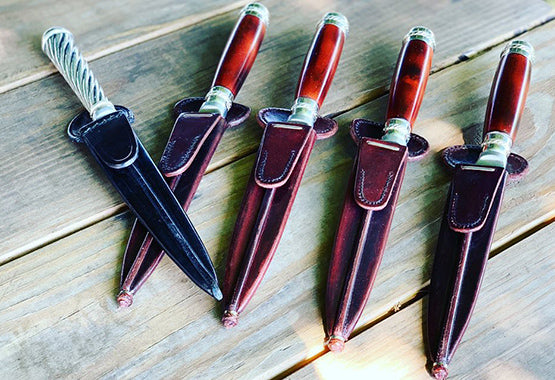Carving Knives
Precision in Culinary Artistry
Carving knives are essential tools in the culinary world, designed for precision slicing and carving. They are typically characterized by a long, thin blade with a pointed tip that enhances precision and maneuverability. This pointed tip allows for easy carving around bones, fat, and cartilage, making them ideal for both raw and cooked meats.

History
The history of carving knives dates back to ancient culinary traditions, where skilled chefs and butchers required specialized tools for precise meat carving. Over time, the design of carving knives has evolved to meet the needs of culinary experts and home cooks alike.
Usage
Carving knives are primarily used for carving large cuts of meat, such as roasted turkey, ham, brisket, and prime rib. Their sharpness and design enable clean, even slices, making them a must-have tool for festive occasions and special gatherings.
Gaucho Knives
Tradition and Utility on the Pampas
Gaucho knives, also known as "facón," hold a special place in South American culture, particularly in regions like Argentina, Brazil, and Uruguay. These knives serve both utilitarian and combat purposes, making them iconic tools of the Gaucho lifestyle.

History
The term "facón" originates from the Portuguese "facão," a large-bladed knife used by Portuguese explorers and settlers during their time in Brazil. Gauchos adopted and adapted these knives to suit their needs during the settlement of South American pampas.
Usage
Gauchos relied on facón knives for various tasks, including utility work like cleaning hooves, cutting meat, and crafting tools. They also used them as weapons when necessary. The facón is typically worn at the back and tucked into the Gaucho's belt for quick access.
Steak Knives
Precision for Your Plate
Steak knives are specialized table knives designed specifically for cutting firm meats, such as steaks and other hearty proteins. They are recognized by their serrated edges and often feature wooden or plastic handles for comfortable use.

History
Specialized steak knives gained popularity in the United States after World War II. Prior to that, table knives were typically sharp but required regular maintenance, including sharpening and polishing. The introduction of stainless steel and serrated blades revolutionized the dining experience.
Usage
Steak knives are essential for diners looking to enjoy their steak and other firm meats with ease. The serrated edge allows for efficient cutting without tearing, ensuring a pleasant dining experience. They are commonly found in steakhouse settings and have become an integral part of the modern dining table.
These knives, each with its unique history and purpose, reflect the cultural and functional aspects of the regions and traditions from which they originate. Understanding their distinctions adds depth to both culinary appreciation and historical context.





0 comments